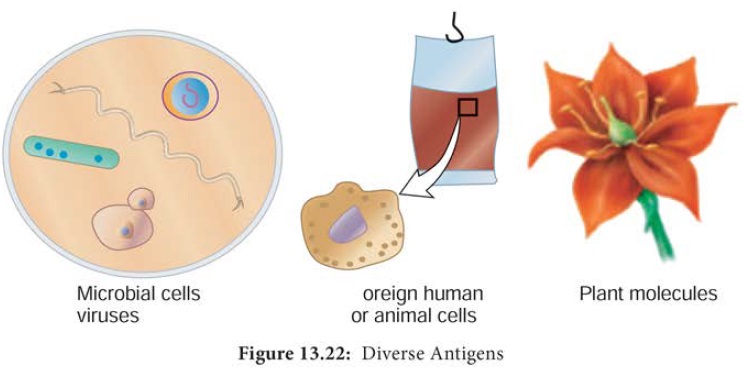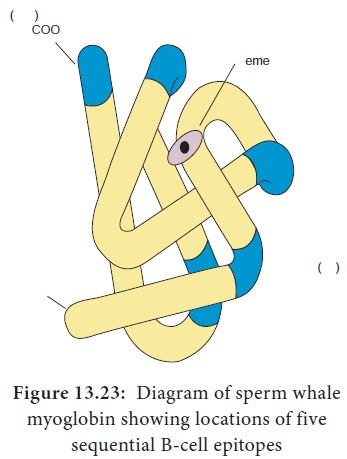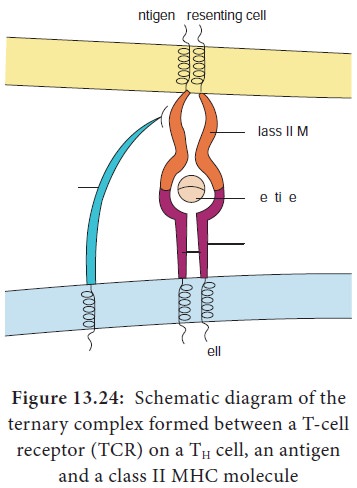Chapter: 11th Microbiology : Chapter 13 : Immunology
Antigens
Antigens
Substances capable of inducing a specific immune response are
called antigens. The molecular properties of antigens and the
way in which these properties ultimately contribute to immune activation are
central to our understanding of the immune system.
Immunogenicity Versus Antigenicity
Two properties are exhibited by antigens; they are immunogenicity and antigenicity. Immunogenicity is
the ability of an antigen to induce a humoral and / or cell mediated
immune response.
B cells + antigen → effector B cells (Plasma cells) + memory B
cells
T cells + antigen → effector T cells (TC, TH
cells) + memory T cells
Although a substance that induces a specific immune response is
usually called an antigen, it is more
appropriately called an immunogen. Antigenicity is the ability of an antigen to combine specifically with the
final products of the above responses. (antibodies and/or cell surface
receptors). All immunogens are antigens but all antigens are not immunogens.
Some small molecules called haptens are antigenic but
incapable, by themselves, of inducing a specific immune response. In other
words haptens lack immunogenicity. Examples of haptens are dinitrophenol,
penicillin and m-amino benzene sulphonate.
Factors that Influence Immunogenicity
Immunogenicity is not an intrinsic property of an antigen but
rather depends on a number of properties of the particular biological system
that the antigen encounters. The factors that influence immunogenicity can be
divided under two categories.
1.
Contribution of the immunogen to immunogenicity
2.
Contribution of the biological system to immunogenicity
1. Contribution of the immunogen to immunogenicity
Immunogenicity is determined in part, by the following four
properties of the immunogen.
A. Foreignness
The immune system normally discriminates between self and non
self, so that only molecules that are foreign to the host are immunogenic. For
example, albumin isolated from the serum of a rabbit and injected back into the
same or another rabbit will not induce an immune response but the same protein
when injected into other vertebrate species (rat) will induce an immune
response.
B. Molecular size
There is a correlation between the size of a macromolecule and
its immunogenicity. The best immunogens tend to have molecular mass approaching
100,000 daltons (Da). Generally, substances with a molecular mass less than
5000-10000 Da are poor immunogens; however a few substances with a molecular
mass less than 1000 Da have proven to be immunogenic.
C. Chemical composition and complexity
Proteins are the most potent immunogens with polysaccharides ranking second. In contrast, lipids and nucleic acids of an infectious agent generally do not serve as immunogens unless they are complexed with proteins or polysaccharides (examples- Lipoprotein or nucleo – protin). For example, attachment of tyrosine chains to the weakly immunogenic protein gelatin markedly enhances its immunogenicity.
D. Susceptibility to antigen processing and presentation
The development of both humoral and cell mediated immune responses
requies interaction of T cells with antigen that has been processed and
presented together with MHC(Major Histocompatibility Complex) molecules. To TH
cells, the antigen must be presented with class II MHC molecules on an antigen
must be presented with class I MHC molecule on an altered self cell.
Macromolecules that cannot be degraded and presented with MHC molecules are
poor immunogens. This can be illustrated with polymers of D-amino acids, which
are stereoisomers of the naturally occurring L-amino acids. Because the
degradative enzymes within antigen presenting cells can degrade only proteins containing
L-amino acids, polymers of D-amino acids cannot be processed and thus are poor
immunogens (Figure 13.22).

2. Contribution of the biological system to immunogenicity
Even if a macromolecule has the properties that contribute to
immunogenicity, its ability to induce an immune response will depend on the
following properties of the biological system that the antigen encounters.
A. Genetic constitution of the host animal
The genetic constitution (genotype) of an immunized animal palys
an important role in determining whether a givensubstance will stimulate an
immune responsiveness is largely made by genes mappin within the MHC
B. Immunogen dosage and route of administration
Whether an immunogenwill induce an immune response also depends on the dose and mode of administration. A quantity of an immunogen that has no effect when injected intravenously may evoke a good antibody response when injected subcutaneously, particularly if it is accompanied by an adjuvant.
C. Adjuvants
The response an immunogen is often enhanced if it is
administered as a mixture with adjuvants. Adjuvants are
substances that enhance the immunogenicity of an antigen. Adjuvants function in
one or more of the following ways. (1) by prolonging retention of the immunogen
(2) by increasing the effective size of the immunogen or (3) by stimulating the
local influx of macrophages and/ or other immune cell types to the injection
site and promoting their subsequent activities. Example: Freund’s incomplete
antigen, Freund’s complete antigen, Mycobacterium
tuberculosis, Aluminum potassium
sulphate (alum) and Bacterial lipopolysaccharide (LPS).
Epitopes
Immune cells do not interact with or recognize an entire
immunogen molecule instead; lymphocytes recognize discrete sites on the macromolecule called epitopes or antigenic determinants. Epitopes are the immunologically active regions of an immunogen that bind to
antigen specific membrane receptors on lymphocytes or to secreted antibodies.
Antigenic epitopes may consist of a single epitope or have varying number of
the same epitope on the same molecule (Example: polysaccharides).

The size of a single epitope may be 4 or 5 aminoacid or
monosaccharide residues. The recognition of antigens by T cells and B cells is
fundamentally different B cells recognize soluble antigen when it binds to
their membrane-bound antibody. (Figure 13.23 & 13.24). Most T cells
recognize only peptides combined with MHC molecules on the surface of antigen
presenting cells and altered self cells.

Haptens and the Study of Antigenicity
The pioneering work of Karl Landsteiner in the 1920s and 1930s
created a simple, chemically defined system for studying the binding of an
individual antibody to a unique epitope on a complex protein antigen.
Landsteiner employed various haptens(small organic
molecules that are antigenic but not
immunogenic). Chemical coupling of a hapten to a large protein called a carrier, yields an immunogenic hapten-carrier conjugate.
Cross-Reactivity
When two antigens possess structurally similar antigenic
determinants, the antibodies obtained to one of these antigens tend to react
with the other antigen. These reactions are called cross reactions.
Related Topics